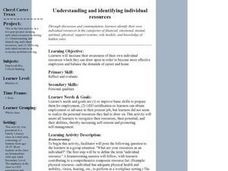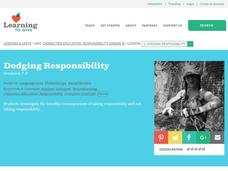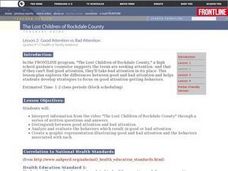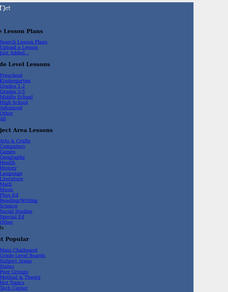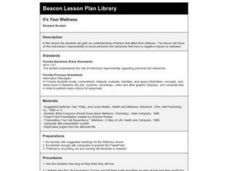Curated OER
Mental Circus
Students listen to different types of music and observe their classmates reaction to the music. They state why they think some reactions happened or did not happen.
Curated OER
Growing on My Own, Kids on the Grow
Students participate in an after school program that promotes critical thinking, concern for others, recognizing differences, accepting differences, self-motivation and personal safety. They cover how kids develop, expressing different...
Curated OER
You Can Stop!!
Students analyze smoking behavior based on peer pressure. In this health lesson, students read and complete worksheets on the internet concerning the behaviors associated with smoking. They summarize what they have learned by...
Curated OER
What Can I Do?
Students identify feelings and learn how to handle conflict. In this character education lesson, discuss what to do when a friend is feeling sad and develop positive ways to handle negative feelings.
Curated OER
Self Acceptance
Students explore their own self concept. They draw a picture of themselves, read a story, and write a story that has a character like themselves. Afterward, they write and illustrate their stories in PowerPoint.
Curated OER
What Can I Do?
Here is a good way for children to identify ways to handle conflict. They discuss the connection between feelings and conflict. Everyone listens to a story about a conflict between two friends and they discuss what they could have done...
Missouri Department of Elementary
Putting on Armor
Middle schoolers learn how to protect themselves from risky behaviors with a instructional activity that has them role play several scenarios and demonstrate ways that they might do to stay safe. Class members then use what they have...
Health Smart Virginia
Walk A Mile in Their Shoes
After watching a presentation that describes the difference between sympathy and empathy, class members fill out an empathy shoe organizer sharing 10 facts about themselves that others may not know. The goal is to create a more accepting...
Just Health Action
What Makes a Community Healthy?
Young people have an opportunity to make it a beautiful day in their neighborhoods with an activity that asks them to identify what is healthy and unhealthy in their community and develop some ideas about what they can do to fix the...
California Department of Education
Hitting the Write Note: Writing a Proposal
To whom it may concern ... Scholars undergo the process of writing a letter to an authority figure. The lesson asks writers to compose a formal letter requesting a music therapy space. Pupils learn how to submit a project proposal to any...
Health Smart Virginia
How the Namuhs Learned to be Content with Who They Are
The Namuhs have a lot to teach humans how idealized images presented in advertising can impact self-perception and self-worth. After brainstorming 10 traits the media sets as the perfect body, class members read a short story about the...
Health Smart Virginia
Suicide Prevention: Finding the Words
Provide young people with the information they need to identify the warning signs for depression and the risk factors for suicide. The instructional activity helps high schoolers learn positive coping skills, role-play how to support...
Health Smart Virginia
Fitting In and Setting Healthy Boundaries
Saying "No" isn't easy. Setting healthy boundaries and sticking to them takes practice. A series of exercises enables sophomores to practice these skills and reflect on the difference between fitting in and belonging.
Health Smart Virginia
Stress Management - Doctor Disease
Doctor, doctor, help me please! As part of their study of the correlation between disease and illness, middle schoolers take on the role of doctors. They rotate through 10 learning stations, read about patients' symptoms, and write a...
Curated OER
Anger (Part 1): Identifying Our Style
Learners identify the two common sources of anger. In this psychology lesson, students discuss productive ways to express anger. They complete a reflection worksheet at the end of the lesson.
Curated OER
Relaxation Station
Second graders explore the Relaxation Station which teaches students how to C.O.P.E. with stress and anxiety. They discover helpful strategies to use in a classroom center.
Curated OER
Small Group Counseling
Students are introduced to the concept of self-esteem and discuss how it is important in friendships. In groups, they counsel one another to determine how one's personal behavior affects the others in their group. They discover the...
Curated OER
Understanding and Identifying Individual Resources
Students identify their own individual resources in the categories of financial, emotional, mental, physical, role models, knowledge of hidden rules, and support systems.
Curated OER
Dodging Responsibility
Learners examine what makes people be responsible. In this responsibility lesson, students chart the good and bad things that happen if you take responsibility and if you don't.
Curated OER
The Lost Children of Rockdale County
Students explore the motivations and consequences of seeking attention, including sexual attention from peers, by interpreting segments of "The Lost Children of Rockdale County" video. They conduct further research on the Internet and...
Curated OER
Child Abuse
Twelfth graders discuss the three major types of child abuse, list the steps of reporting child abuse, and identify the warning signs of child abuse.
Curated OER
Understanding Abuse
Students are introduced to the various forms of child abuse. Using the internet, they discover the proper ways to report abuse to adults and the warning signs of someone being abused. In groups, they complete a case study to end the...
Curated OER
It's Your Wellness
Pupils define wellness and take a Life Expectancy Survey. They discuss factors that affect wellness, view a Powerpoint presentation on wellness, and design a mouse pad that demonstrates how to avoid negative personal risk behaviors.
Curated OER
Dysfunctional Eating
Sixth graders write a 1.5 page paper explaining how to make their favorite nutritional snack. They need to assume that the audience has never seen or heard of the snack before.



















